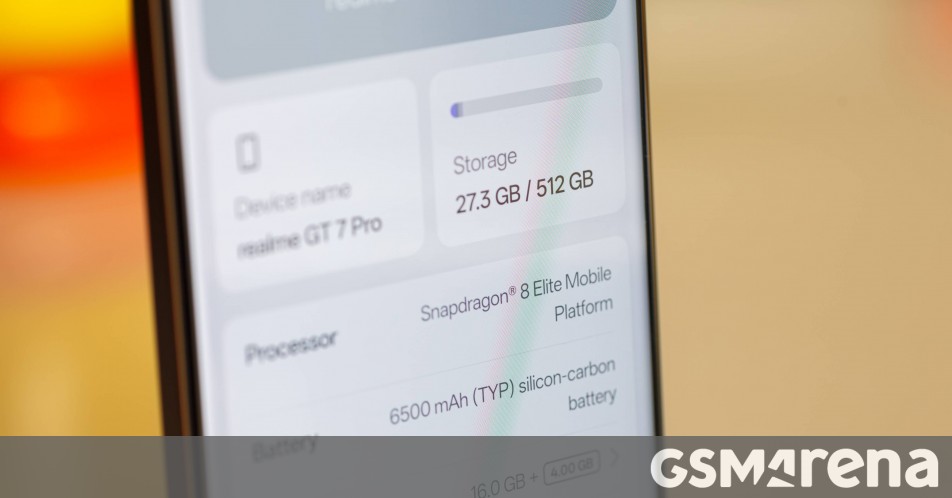The Snapdragon 8 Elite represents a new hope in the mobile field – it’s the first chipset in a long while that has custom CPU cores (and isn’t coming out of Apple). The GPU is all custom too and a new generation to boot. And Qualcomm found a way to boost the clock speed higher than any other smartphone chipset by quite some margin. It all looks great on paper, let’s see whether expectations meet reality.
Here we will focus on how the 8 Elite compares against the two previous generations of Snapdragon 8-series. We are working on a separate post that will pit the Elite against its chief rival, the Dimensity 9400.
We will be using the Realme GT7 Pro for this test
We will be using the Realme GT7 Pro for our first round of tests for the Snapdragon 8 Elite. And as mentioned above, we’ve picked out some Snapdragon 8 Gen 3 and 8 Gen 2 phones for comparison. Some of these are gaming phones, so they should represent the best possible performance of the older chipsets. To that end, we should mention that we put the phone in GT mode (i.e. high performance mode) for these tests.
Let’s look at the CPU first as that is the biggest change this generation. It uses Oryon cores, two versions of them – two Prime cores and six Performance cores. These aren’t Cortex cores like in MediaTek and Samsung chipsets, but an in-house design from Qualcomm. Note that these aren’t the same Oryon cores that we saw in the Snapdragon X Elite in laptops, but instead a second generation.
2x 4.32GHz Oryon prime cores + 6x Oryon performance cores
The two Prime cores run at up to 4.32GHz, which is an insane speed for a pocketable device. Apple’s A18 Pro broke the 4GHz barrier earlier this year, but only just – it runs at up to 4.05GHz. The Dimensity 9400’s Cortex-X925 stays below 4GHz and runs at 3.63GHz. Outside of laptops, the highest clock speed you can find on a mobile device is the Apple M4 in the iPad Pro (2024) tablets at 4.4GHz. But do keep in mind that these are 11” and 13” tablets and have a much easier time keeping cool.
Looking at Geekbench 6, the phones neatly group themselves into generations. The 8 Elite represents a massive 31% boost in multi-core performance over the best 8 Gen 3 results – and those come from gaming phones in maximum effort mode and the overclocked “for Galaxy” chip in the S24 Ultra.
Flipping over to the single core test, this is where the high-frequency of the Oryon Prime cores should shine. And shine it does with a blinding 36% lead over the best of the rest. Looking back another generation, the Oryon posts double the score of some 8 Gen 2 phones (Cortex-X3 Prime core) or just a 52% higher score than the best 8 Gen 2 phone in its top performance mode.
Let’s look at graphics next. The Adreno 830 is built on a new architecture using a sliced design with dedicated memory for each slice. The 830 has three of these slices clocked at up to 1.1GHz.
Three GPU slices at up to 1.1GHz, plus dedicated memory
Once again, the generational divide is quite clear. The 3DMark Wild Life Extreme test (running at 2160p) posted a score 21% higher than the best we’ve seen from Snapdragon 8 Gen 3’s Adreno 750. Going back to the 8 Gen 2, the difference is a stunning 68%.
The 8 Elite brings the latest iteration of hardware-accelerated ray tracing. This tech is gaining ground on mobile after getting established on desktop first. The two-year old 8 Gen 2 GPU only manages around half the score of the new Elite chip. The difference with the 8 Gen 3 is a tamer 26%, but that is still an impressive generational improvement.
Finally, AnTuTu tries to combine CPU, GPU, memory and other tests into a singular score that represents overall performance. With all these factored in, there is a lot more variability – a well-specced 8 Gen 2 phone can come close to a less performant 8 Gen 3 phone. But once again the Snapdragon 8 Elite – or rather the Realme GT7 Pro that houses it – leads the older models by some margin (around 25%).
This is not the end of this story, just the first chapter. We still have more tests to run, including the all-important sustained performance test. We also need to run tests with GT mode disabled (we did run a few and the phone didn’t lose much performance).
We also encountered some troubles during testing, but this might just be due to teething issues – the full Realme GT7 Pro reveal is scheduled for November 4, although the company has confirmed some details already and is even letting us run some tests on the review unit we have at the office.

